|
Dan Suthers
| Today we compared shallow reef habitat to deeper waters around La Perouse pinnacle. Participants report: The fish here seem "at least twice as big as the ones at home." We were awed by large ulua and Honu and enormous Manta Rays. "When I jump in, within 10 seconds I know I am in a special place where nature dominates." ... "sensory overload!" After returning, teachers were busy planning reports and lessons, and tonight Malia gave a great presentation on the relationship between management and science. |

Talk About It!
|
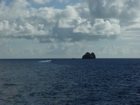 

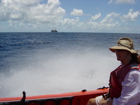
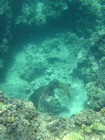

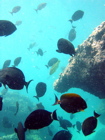


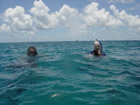



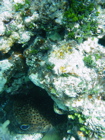





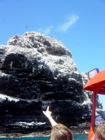


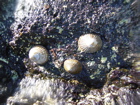

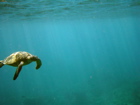


 







(note: turtle approached the startled photographer, who was motionless)
(Links to larger versions will be provided after we return.)
 Talk About It! Talk About It!
Endemism and human occupation in the NWHI
Asked by David (Clivus) from Mililani High School on Aug 16, 2005.
My question consists of two parts:
1. Do the NWHI have endemic flora and fauna?
2. Did Hawaiians establish permanent settlements in the NWHI? If so, on which islands did they live and where did they obtain fresh water?
Mahalo for your consideration.
Answered by Dan Suthers and Sabra Kauka on Aug 17, 2005.
1. Do the NWHI have endemic flora and fauna?
Absolutely! In fact the rate of endemism is very high. According to a publication "Coral Reef Ecosystems of the Northwestern Hawaiian Islands" reporting on results of baseline surveys in 2000, "About one fourth of the shallow water species inhabiting reefs in the Hawaiian Islands are endemic ..." (this includes ALL of the Hawaiian Islands), and the survey found that NWHI endemism is as high or higher than the "main" islands. An article by DeMartini and Friedlander published in Vol. 271 of Marine Ecology Progress Series reports that fish endemism increases with latitude, being highest in the four northernmost reefs. Many of the islands have birds that are endemic to those islands (they aren't found naturally anywhere else in the world), for example the Laysan duck and Laysan finch (two other bird species endemic to Laysan are now extinct) and the Nihoa Finch and the Nihoa Millerbird. A second Laysan duck population was recently established on Midway by translocation. There are also endemic plants, such as the Nihoa palm, which is now being cultivated on Laysan.
Dan Suthers
2. Did Hawaiians establish permanent settlements in the NWHI? If so, on which islands did they live and where did they obtain fresh water?
Archeological evidence indicates that Hawaiians lived on the NWHI of Nihoa and Mokumanamana (Necker). Nihoa has 88 sites, and Mokumanamana, has 52 indicating that both were used extensively in the past. The settlement pattern of the two islands is quite different. Nihoa is characterized by massive habitation sites and extensive agricultural terraces. Mokumanamana, on the other hand, has numerous religious shrines and almost no other types of sites. It is postulated that Nihoa supported a sizable semipermanent population, while visits to Mokumanamana were probably always temporary.
Both islands appear to be inhospitable and unsuitable for human occupation. They are steep, rainfall is scarce, and the soil is rocky. There are extremely large bird populations and abundant marine resources. There is a spring on Nihoa that may have supplied fresh water for part of the year. There is no spring evident on Mokumanamana. Archeologists have found stone bowls on both islands that may have served to catch rainwater.
Sabra Kauka |